
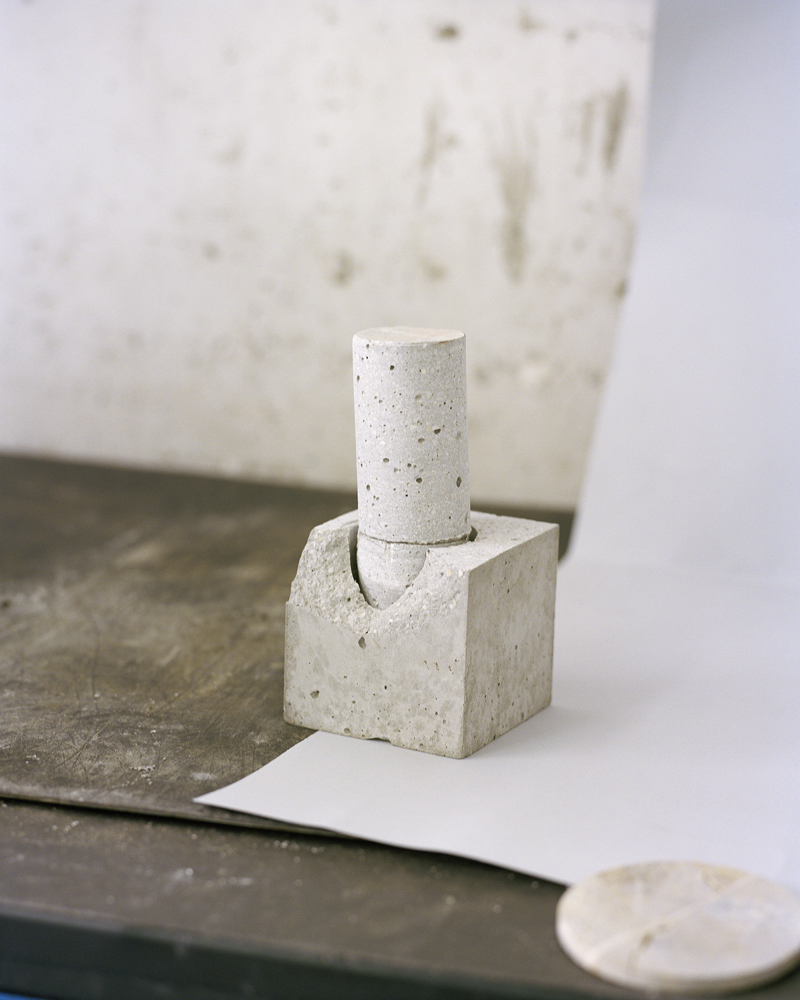




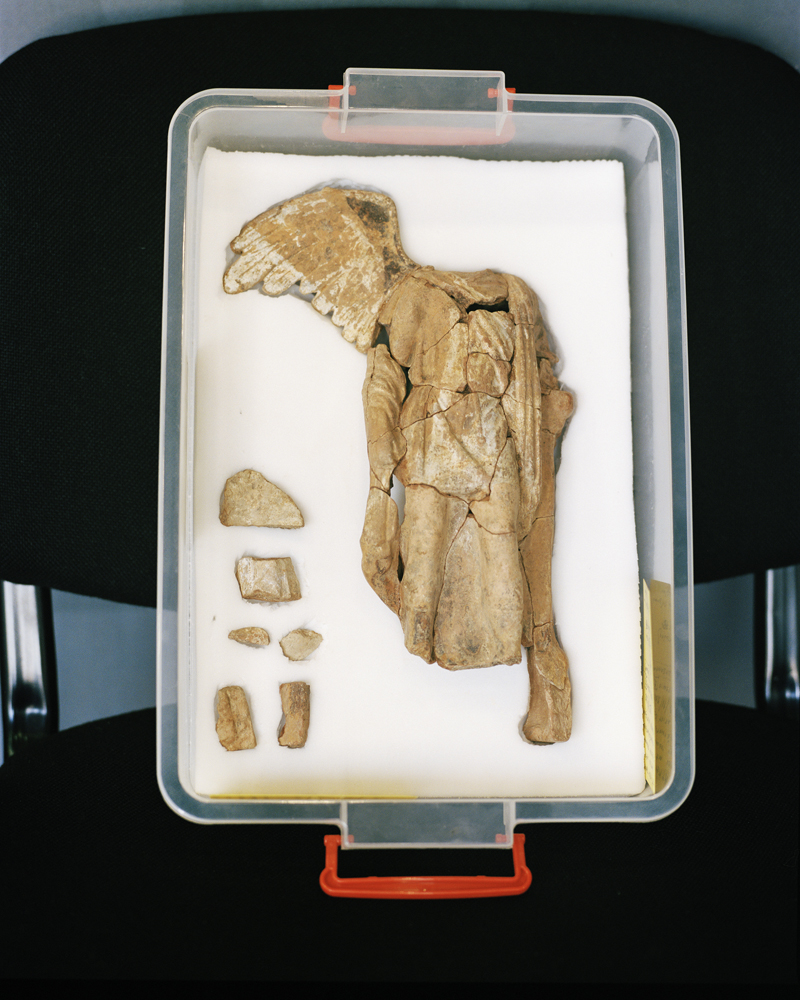




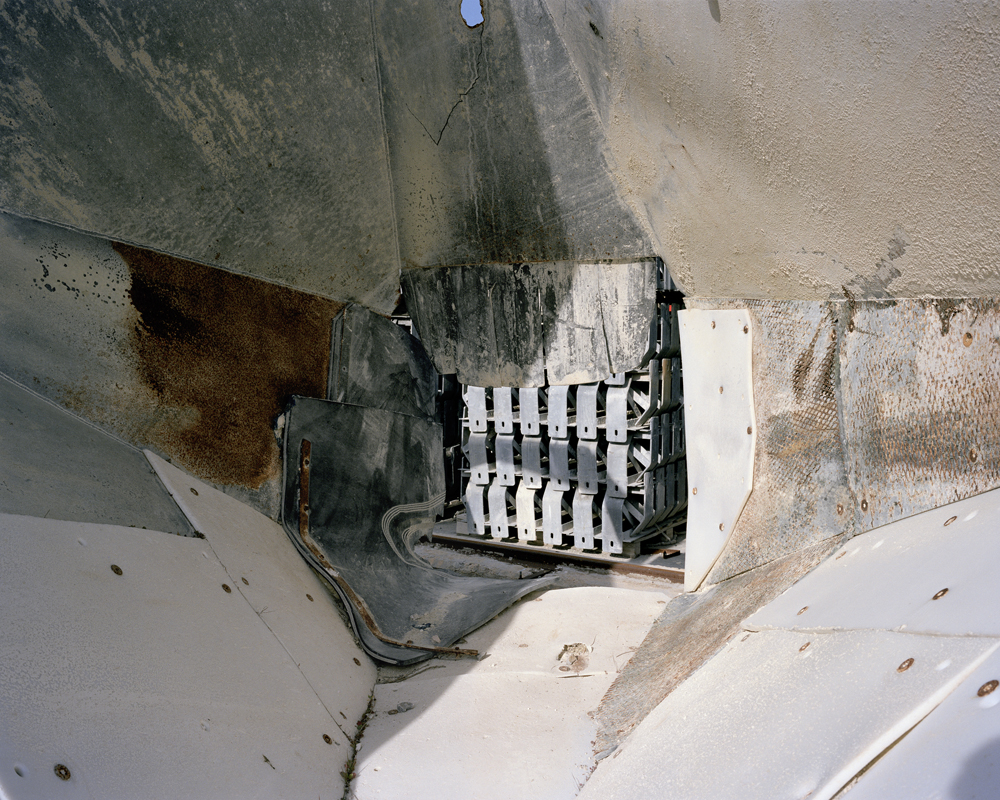

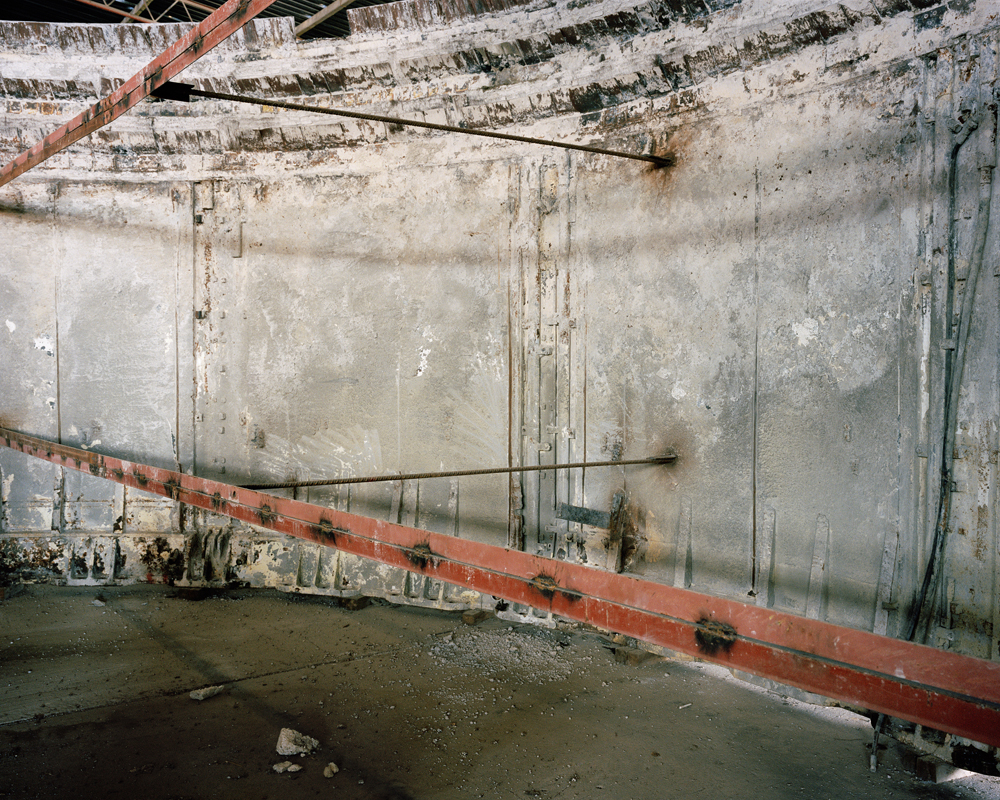





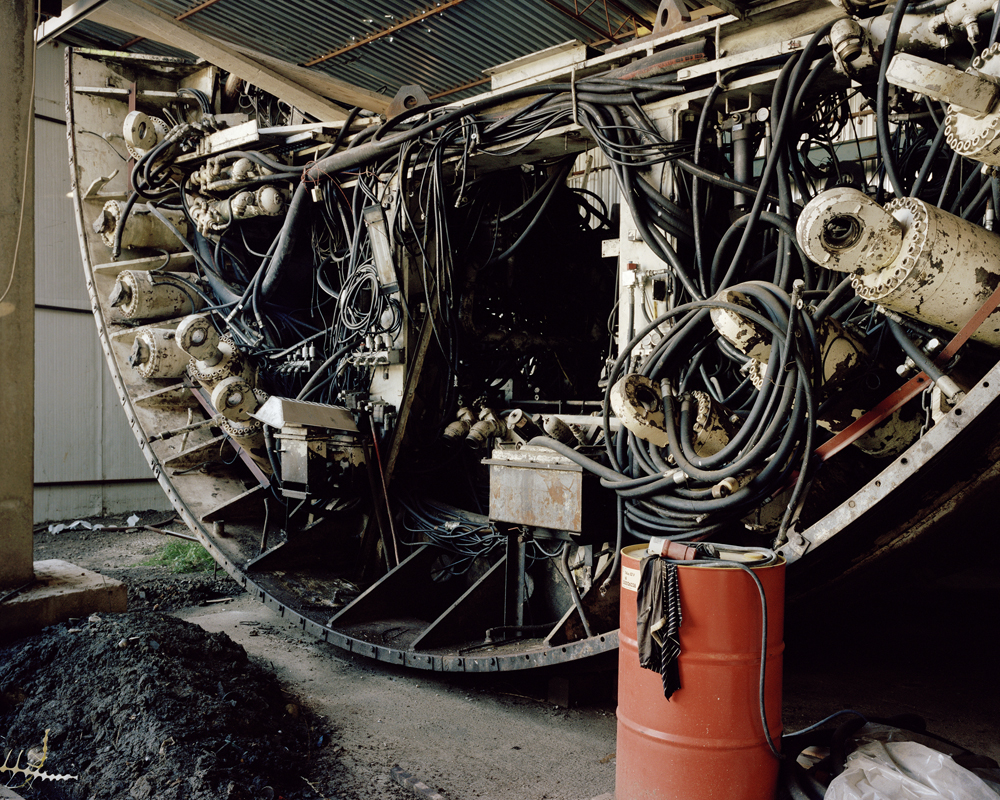







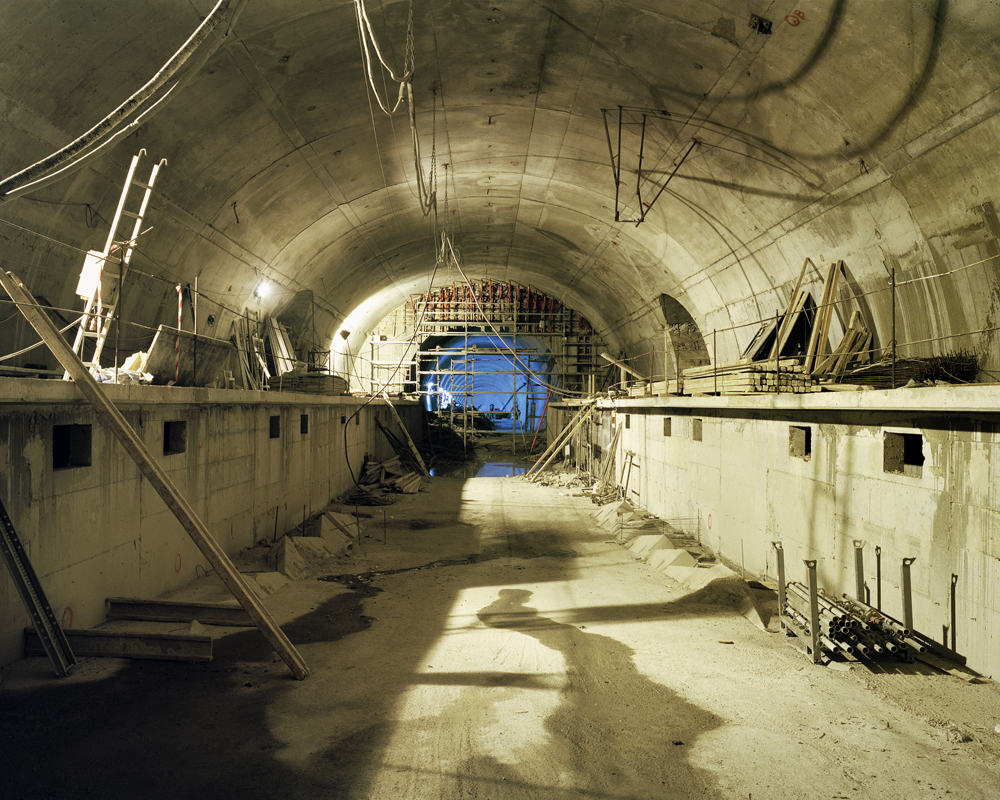
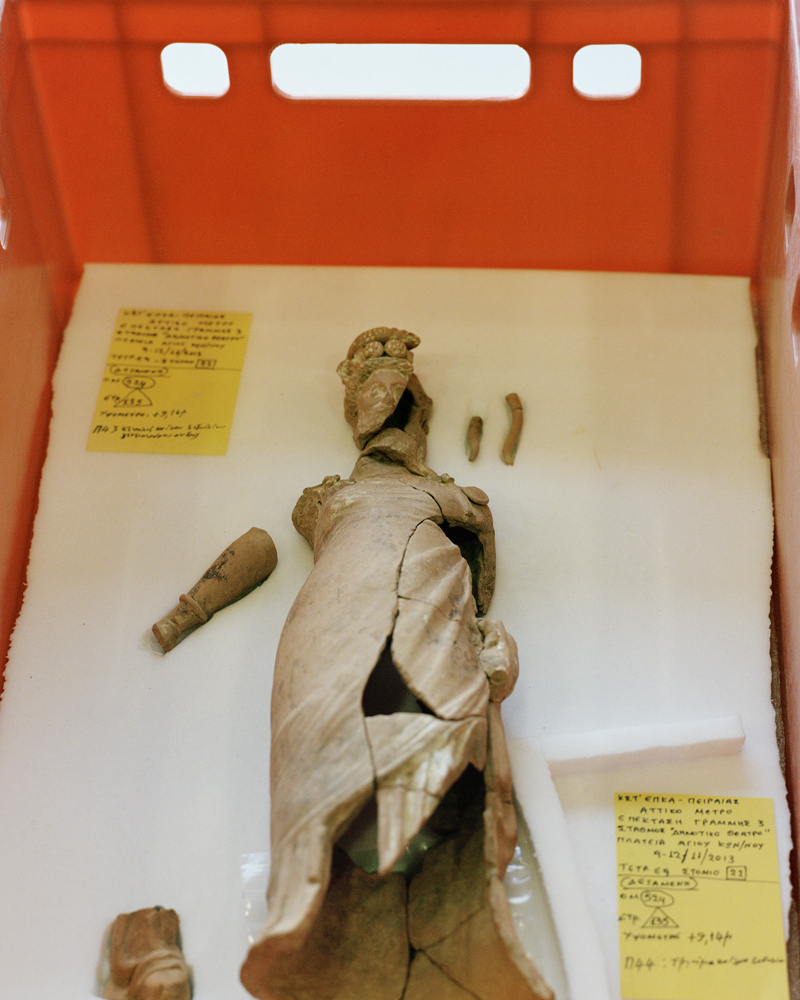




Athens Metro Line 3 Extension - Ghella s.p.a. - 2020
Curated by Alessandro Dandini de Sylva
HIPPODAMUS
Marina Caneve and Alessandro Dandini de Sylva in Conversation
AD: It is traditional to name mechanical cutters (commonly known as moles or TBM, as in Tunnel Boring Machine) after women. Nonetheless, the mole that dug the section of the Metro 3 in Athens, connecting Haidari, a suburb in the western part of the city, to Piraeus, was given the name Ippodamo, after Hippodamus of Miletus. Hippodamus was one of the first to have theorized not just an urban plan but also an actual master plan, using the earliest practices of zoning. Your work, which can easily be divided up into several chapters or groups of images, seems to be inspired by that practical archaic division of the territory.
MC: Photography and urban planning, at least according
to how I have learned to view them, have in common the need for an approach that is, on the one hand, rigorous, and, on the other, curious, exploratory. Hippodamus is considered one of the fathers of modern urban planning, the “inventor” of the grid framework for the city – also used to build the port of Piraeus. Aristoteles uses the name μετεωρολοᾒγος to refer to him, which could be translated scholar of celestial phenomena, or, with a hint of irony, he who gazes at the sky. Precisely because of his eclectic, eccentric, almost mocking biography, Hippodamus was a crucial travel companion in my own work because, on the one hand, he reminded me that I had to go by the rules, yet, on the other, that I was free to break them. Dividing is the same as zoning the elements while delving deep into the relationship between the parts, overturning them in an implacable yet delicate way, to reassemble them in con- figurations of balance. If we imagine a mosaic, its effect is produced via the deformation of a grid; each stone has its own value, based on its position, shape, colour, but, above all, its individual specificity, which is unique and unrepeatable.1 Though the individual stones share certain features, their position is determined by a more complex design. Furthermore, the fact that the TBM that was used to dig the tunnel that completes the route plan of Athens’ Metro 3 – which connects Eleftherios Venizelos Airport to the Port of Piraeus – bears its name has driven the initial idea of the division, or rather organization, even more to the limit, forcing me to reason, on the one hand, on tech- nological innovations, and, on the other, on the origin of places. A reminder that if the sky is traversed by Apollo’s Chariot, in the sea we have Poseidon.
AD: The pictures you took are arranged in the book in an intricate forest of themes that can be related to the rela- tionship between the city (present), contemporary plan- ning (future), and historical memory (past). In turn, the latter is articulated in historical, geological, and industrial archaeology. Views of the city and the building site are alternated with archaeological finds, core drillings, and TBM parts. A visual stratification that is a common thread in your artistic practice.
MC: In the stratifications – and it is especially for this reason that they interest me – the elements contribute to suggest- ing stories that can shift in space and in time. My work unfolds around a series of fragments. Arranging them is a mnemotechnical operation, where the ability of our intellect lies in the capacity to pay attention to individual things and to their assembly at the same time. Hence, it lies in the ability to discern and to synthesize. If we ana- lyze the relationships between the images and the strati- fications of “archaeologies”, I am enthralled by the idea that our relationship with history is a relationship with images that are predetermined and etched in our mind. In today’s age, we find traces of our origins, and manifested in the stratification is the architecture of our imaginary. Besides being similar to that of the urban planner, the photographer’s work is not so different from that of the archaeologist: in both cases it involves finding traces and bringing them to light. Agamben teaches us that archae- ology is the search into the past for the possibility of the present, where it itself can be understood as the search for a point of the outset of what is possible, where the column fragments that lie on the ground in flakes go back to being columns.2
AD: Your working method seems to coincide with that of the modern archaeological dig, and more precisely with the stratigraphic dig, whose aim is not limited to the extraction of artefacts from the earth that hides them, but consists in a historical understanding of the human traces hidden in the stratification.
MC: When thinking to Athens it is natural to think to archaeology. In archaeological digs we can find a conso- nance of nature, a contemporary way, and artefacts (often naturalized by the fact that they are in ruins). I wanted to view the building site with this approach, as though I were observing an archaeological dig, analyzing the elements from broad and all-encompassing visions down to the microscopic details. I arrived in Athens at a time in the life of the building site when the traces of the digging of the tunnel were fading. A backwards tunnelling, which I was able to approach right when it was being closed, seeking the signs in the design of the city, in the environment, and in the pre-existing urban fabric. The views are proof of this process. They do not just tell the story of the mor- phology of a territory characterized by dense urbaniza- tion, but they also let us glimpse traces of a complex work process, its healing and disappearing beneath the skin, to become new lifeblood for the city.
AD: In a recent exchange of ideas and references, you spoke to me about the thoughts of Giancarlo De Carlo, Italian architect, urban planner, and academic, who for over thirty years travelled across the Greek archipelago, visiting its monuments and cities. De Carlo believed in complexity, in disorder as order in a complex nature that we cannot decipher. Building an image with a new impressive infra- structure in relation to the city of Athens leads to accept- ing its complicated order as part and parcel of the work.
MC: De Carlo’s journeys to Greece tell us about “Athens, immense and studded with myths”, but also about Athens being totally balanced amidst the chaos. When you told me I was going to go to Athens I was eager because it is a place whose nature – stratified and chaotic – is very close to my way of thinking, my work, and where, in the disar- ray, I have the feeling I can find the quiet of the ideal city of Piero della Francesca. In truth, the disarray is a place where lateral narratives overlap, they are like the branches that are grafted onto the main story, information, news, pieces and conjectures overlap.3 The best way to under- stand a place is to observe the signs left by the architecture in nature. I imagined the tunnel like a tree trunk, with branches that, on the one hand, are the grafts – the shafts, the emergency exits –, on which I chose to stop my gaze because, as is customary for me, I don’t so much seek the spectacular and the magnificent, the direct, as much as I try to look at things from a peaceful and angular perspec- tive. Along with these ramifications, all the digressions possible were manifested, starting from the question of the tunnel. The finding of ancient wells filled with archaeolog- ical finds, the problems related to the city’s geology, and, lastly, the components of the TBM that, in turn, become archaeological finds, albeit on a totally different scale, and that tell us of the relationship between the machine and the contemporary city. The lateral vision pushes us towards an agnosticism of thinking. Inspired by the litera- ture by Sebald, the constant rambling produces a hypnotic narrative that ends up representing life and its branches, perhaps more faithfully with respect to documentary reproductions, where each thing happens to satisfy an internal logic and a coherence that is not really realistic. All these very important angular visions allow me to think about how the city takes shape, where the significance and the meaning of the monuments (and by extension of our cities) do not depend on their original destination, but rather it is we, modern subjects, who attribute them.4
1. Yona Friedman, L’ordine complicato. Come costruire un’im- magine (Macerata: Quodlibet, 2018).
2. Giancarlo de Carlo, Viaggi in Grecia (Macerata: Quodlibet Abitare, 2010).
3. Ibid.
4. Alois Riegl, Le culte moderne des monuments: son essence et sa genèse, (Paris: Éditions du Seuil 1984).